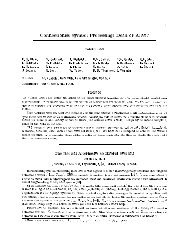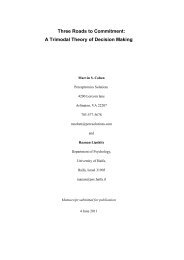Three Roads to Commitment: A Trimodal Theory of Decision Making
Three Roads to Commitment: A Trimodal Theory of Decision Making
Three Roads to Commitment: A Trimodal Theory of Decision Making
Create successful ePaper yourself
Turn your PDF publications into a flip-book with our unique Google optimized e-Paper software.
<strong>Three</strong> <strong>Roads</strong> <strong>to</strong> <strong>Commitment</strong>: A <strong>Trimodal</strong> <strong>Theory</strong> <strong>of</strong> <strong>Decision</strong> <strong>Making</strong> 29<br />
implementation <strong>of</strong> A (P1), <strong>to</strong> the action commitment (A replaced by B and P2), and finally all the way <strong>to</strong> the<br />
diagnosis (C). There is no logical error in explaining (away) unexpected results by peripheral adjustments. Where<br />
changes are made is a matter <strong>of</strong> judgment based on experience. In TDM, this increasingly central questioning is<br />
driven by overall implausibility <strong>of</strong> the account <strong>to</strong> which the diagnosis C is central, which increases each time a<br />
problem is explained away and then influences the level at which subsequent explanations are attempted. 13<br />
Dominance Structuring and Argument-based <strong>Decision</strong> <strong>Making</strong><br />
Montgomery (1993) describes a choice strategy called dominance structuring, which bears a striking<br />
resemblance <strong>to</strong> the s<strong>to</strong>ry-telling strategy in matching. The decision maker starts by intuitively selecting a particular<br />
option, and reassesses it by attempting a justification. Problems with the favored option are dealt with by adjusting<br />
peripheral assumptions: for example, decision makers take a goal on which the option does poorly (or a rival does<br />
well) and dismiss it as unimportant, combine it with other goals in<strong>to</strong> a more comprehensive objective (on which the<br />
favored option comes out best), or reassess scores. (S<strong>to</strong>ry telling may even be enlisted as part <strong>of</strong> dominance<br />
structuring, <strong>to</strong> explain why the favored option has better outcomes than its rivals.) The aim is <strong>to</strong> construct a potent<br />
argument for the initial course <strong>of</strong> action, i.e., one in which that option is as good as or better than all other options<br />
with respect <strong>to</strong> all goals. As in s<strong>to</strong>ry building, the exercise may be more than mere rationalization. Montgomery<br />
(1993) cites evidence that if a justification cannot be plausibly constructed, decision makers tend <strong>to</strong> abandon their<br />
initial intuitive selection. The best option, at the end <strong>of</strong> this process, is the one whose rationalization is most<br />
convincing (Tetlock, 1996) – i.e., involves the least revision <strong>of</strong> initial intuitions about values and goals.<br />
There are many kinds <strong>of</strong> action arguments other than s<strong>to</strong>ries and dominance structures, with different organizing<br />
principles that lead <strong>to</strong> different details in the handling <strong>of</strong> uncertainty. For example, sketches play the role in some<br />
fields, e.g., architectural design, that s<strong>to</strong>ries do in others (Cross, 2006, 2007; Schön, 1983). According <strong>to</strong> Cross<br />
(2006, p. 116), “Sketching is tied in very closely with features <strong>of</strong> design cognition, such as the generation and<br />
exploration <strong>of</strong> tentative solution concepts, the identification <strong>of</strong> what needs <strong>to</strong> be known about the developing<br />
concept, and especially the recognition <strong>of</strong> emergent features and properties… Concepts drafted in design sketches<br />
are there <strong>to</strong> be criticized, not admired; and they are part <strong>of</strong> the activity <strong>of</strong> discovery, <strong>of</strong> exploration, that is the<br />
activity <strong>of</strong> designing.” In a typical design task, according <strong>to</strong> Cross (2006, p. 114), a “solution conjecture,” i.e., a<br />
13 TDM predicts that more experienced or expert decision makers will behave like Rudolph’s (2003) most effective<br />
group (note 12): They will not reject a plausible action commitment at the first sign <strong>of</strong> trouble, but will do so when<br />
problems accumulate. Other decision makers may reject commitments either <strong>to</strong>o soon, or <strong>to</strong>o late (or never).




